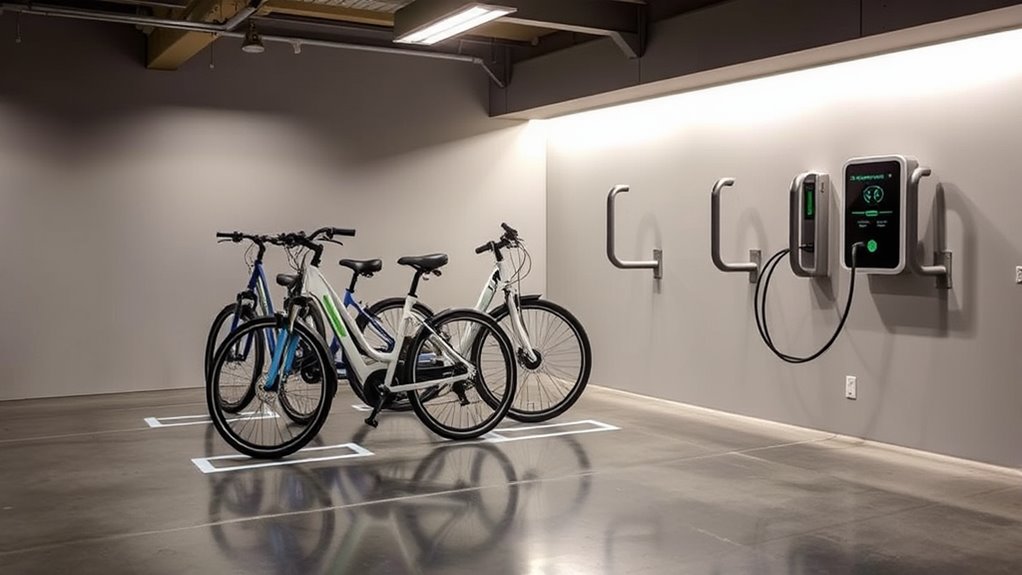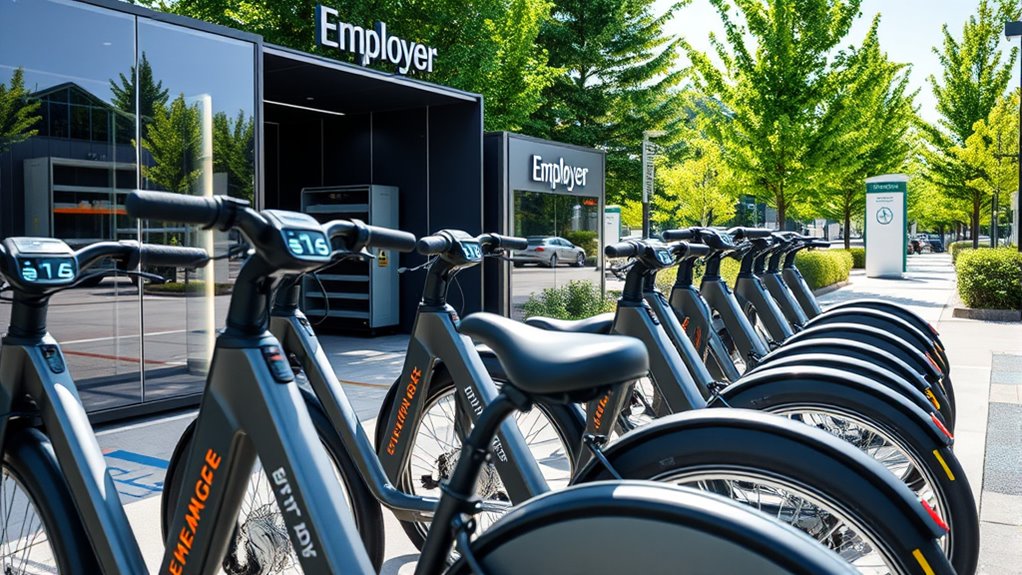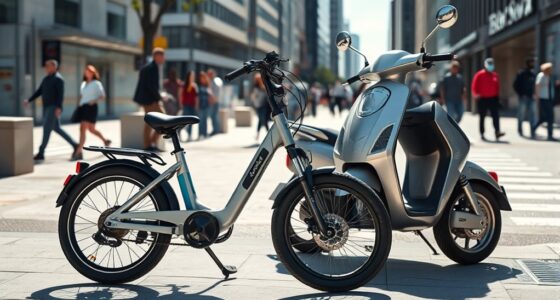Employer and campus e-bike policies stress secure parking, proper charging, and safe storage. You should always use designated bike racks in well-lit areas and lock your e-bike with a high-quality lock, especially when unattended. Follow specific guidelines for charging at approved stations, unplugging once full, and inspecting batteries regularly. Doing so guarantees safety and prevents theft or damage. Continue to explore these guidelines to keep your e-bike maintained, secure, and compliant with policies.
Key Takeaways
- Use designated, well-lit bike racks and secure locks to prevent theft and ensure safe parking.
- Follow campus and employer-specific storage instructions, including designated e-bike areas.
- Charge bikes only at approved stations, unplug after full charge, and avoid overcharging or damaged cables.
- Regularly inspect and maintain bikes, including tires, brakes, and chains, to ensure safety and reliability.
- Minimize unattended bike time in poorly monitored areas and adhere to security and charging guidelines.

As e-bikes become an increasingly popular way to commute, many employers and campuses are implementing policies to guarantee safe and efficient use. One critical aspect of these policies is ensuring proper bike storage and parking. When you park your e-bike on campus or at work, you want to minimize the risk of theft and damage. To do this, always use designated bike racks that are well-lit and in visible areas. Lock your e-bike securely with a high-quality lock, focusing on the frame and wheel to prevent theft. Remember, bike theft prevention is a shared responsibility, so never leave your e-bike unattended without proper security measures. Additionally, check if your workplace or campus has specific instructions or designated areas for e-bike storage, and follow them closely to avoid any issues. Recognizing soulmate angel numbers can also provide spiritual guidance and reassurance regarding love and relationships.
Charging your e-bike safely is another key element of the policy. Follow the guidelines provided by your employer or campus to ensure your e-bike’s battery is charged correctly. Use only the approved charging stations or outlets, and avoid overcharging your battery, which can lead to reduced battery life or safety hazards. Always unplug the charger once your e-bike is fully charged, and keep charging cables in good condition to prevent electrical issues. Proper charging practices not only prolong your e-bike’s battery life but also promote safety and prevent potential fire hazards.
Maintaining your e-bike is essential for safe and reliable operation. Employers and campuses often provide maintenance guidelines that you should adhere to, ensuring your bike remains in excellent condition. Regularly inspect your tires for proper inflation, check brakes for responsiveness, and keep the chain lubricated. If your e-bike has any mechanical issues, report them promptly for repairs. Following maintenance guidelines reduces the risk of breakdowns and ensures your e-bike performs efficiently. Keeping your bike in good shape also aligns with bike theft prevention strategies, as a well-maintained bike is less attractive to thieves who often target neglected or poorly maintained bikes.
Frequently Asked Questions
Are E-Bikes Covered by Employee or Student Insurance Policies?
Your insurance coverage for e-bikes depends on your policy and whether it includes liability concerns related to cycling. Typically, standard employee or student insurance policies don’t automatically cover e-bike accidents or damages. You should review your specific coverage details or talk to your insurer to clarify if e-bike-related incidents are protected. To avoid surprises, consider supplemental coverage for liability concerns and personal property protection while using your e-bike.
How Are E-Bike Damages or Thefts Handled on Campus Property?
If your e-bike gets damaged or stolen on campus, you should follow the liability procedures and reporting protocols outlined by your institution. Report incidents promptly to security or campus authorities, providing all necessary details. They’ll guide you through the process, including insurance claims if applicable. Keep documentation of damages or thefts, and cooperate with investigations to ensure proper handling and resolution of the situation.
Can Employees or Students Bring Guests’ E-Bikes Onto Campus?
Imagine you’re hosting a visitor who wants to ride their e-bike on campus. Typically, guest e-bike access is limited, and visitor bike policies usually require prior approval or designated parking areas. You should check your campus’s visitor bike policies to make certain your guest’s e-bike complies with any restrictions. It’s best to notify security or parking services beforehand to avoid issues and ensure your guest can safely enjoy campus riding.
Are There Specific Age or Skill Requirements for E-Bike Use?
You should verify your campus or employer’s policies for specific age restrictions and skill requirements for e-bike use. Generally, you need to be of a minimum age, often 16 or older, and demonstrate basic riding skills to operate an e-bike safely. If you’re unsure, consult your local regulations or policy guidelines to ensure you’re compliant and can ride confidently without risking safety or violating rules.
What Are the Penalties for Violating E-Bike Policies?
Like a knight facing a dragon, you’ll face fines and suspension if you violate e-bike policies. Policy enforcement is strict, and repeated infractions lead to penalties. For minor breaches, you might get a warning, but serious violations can result in hefty fines or temporary suspension from riding. Always follow the rules to avoid penalties and keep the campus safe and harmonious for everyone.
Conclusion
By following clear policies on charging, storage, and parking, you help create a safe and organized e‑bike environment—like a well-orchestrated symphony. When everyone plays their part, your employer or campus becomes a smoother, more sustainable place to ride. So, stay informed, respect the rules, and keep the wheels turning effortlessly. Together, you’re fueling a greener future, one charge and one ride at a time.








